Wildflower Fever!—A Selection of Unusual Natives
I first became aware of native wildflowers in my youth, while playing down by the creek that runs through the woods near my hometown of Falls Church, Virginia. Sightings of plants such as jack-in-the-pulpit, lady's slipper orchid, and Indian pipe were pretty commonplace there. But, like the other kids, I was too busy chasing after salamanders and crayfish to take much notice.
It wasn't until I became an avid gardener and birdwatcher in later life that I began to seriously consider this continent's plant heritage. The more I learned about the extent to which our wild habitats have been degraded by development and by the monopolizing habits of many non-indigenous species, the more I came to appreciate the plants I'd known so casually as a child.
Nowadays, I fill my garden with beautiful wildflowers. Besides increasing biodiversity in and of themselves by augmenting the shrinking populations and gene pools of native species, they provide a valuable source of food for insects and birds.
But what is native for me may not be native for you. The United States is made up of at least six ecologically distinct regions, or floristic provinces, each supporting a complex community of plants, animals, and insects. (The plant list in this article is organized accordingly.) To get optimal performance out of a wildflower, therefore, it's important to know its native range as well as the kind of habitat it prefers.
In the interest of making gardeners throughout North America more aware of our own botanical riches, I interviewed specialists at native plant nurseries from all six floristic provinces and had them recommend some choice, but lesser known, wildflowers. Zones refer to the USDA Hardiness Zone Map.
Northeast & Mid-Atlantic
Aster carolinianus (Climbing aster)
"This rare native is often in bloom on Christmas Day!"
—Dennis Niemeyer & Joani Lawarre, WE-DU Nurseries
Provide a trellis or post and this amazing aster will climb over 30 feet to get to the top. It has a fine grayish down, and is shrubby, with arching stems
and narrow mid-green leaves. Its many flowerheads are a light, purplish pink and pop open in September and October (or year-round in the swamps from Florida
to North Carolina) to reveal spidery, rose-pink flowers that mature to lilac. This tough plant thrives in dry, average, or moist soils. Full sun or light shade.
Zone 7-9.
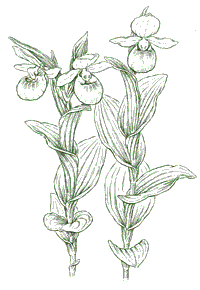
Cypripedium reginae (Royal lady's slipper)
"The Cypripediums are now coming to market from tissue culture and seedlings. Soon all gardeners will be able to have the lady's slippers they have lusted after in the wild."
—Gene Bush, Munchkin Nursery & Gardens
This "queen" of eastern wildflowers produces incredible crystalline-white flowers with bright pink lips. The leaves are broad and strongly plaited.
Basically, this is a bog orchid and requires moist, fertile, leafy, humus-rich, neutral to acidic soil, in a sheltered site. 30 inches tall; 12-inch spread.
Zone 6-9.
Uvularia grandiflora (Large merrybells)
"Beautiful and easy specimen plant for shade."
—Charles Oliver, The Primrose Path
This 18-24 inch clump-forming perennial has erect lily-like leaf stems and
slightly hairy leaves. The pendulous, twisted, bell-shaped, lemon-yellow
flowers are 1-1/2 inches long and nod gracefully in mid- to late-spring. Use in
the border foreground or in masses as a ground cover. Easy to grow in
humus-rich, moist, but well-drained soil and deep or partial shade.
Zone 3-7.
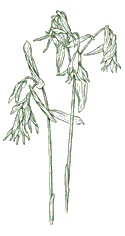
And don't forget some of the old favorites of the Northeast and Mid-Atlantic region: Antennaria diocica (pussytoes), Amsonia tabernaemontana (willow blue-star), Aquilegia canadensis (Canada columbine), Arisaema triphyllum (jack-in-the-pulpit), Asclepias tuberosa (butterfly weed), Baptisia australis (blue false indigo), Caltha palustris (marsh marigold), Disporum maculatum (nodding mandarin), Gentiana andrewsii (closed gentian), Geranium maculatum (spotted geranium), Hypoxis hirsuta (yellow star grass), Iris verna (dwarf iris), Jeffersonia diphylla (twinleaf), Liatris squarrosa (scaly blazing star), Lobelia cardinalis (cardinal flower), Pachysandra procumbens (Allegheny spurge), Penstemon digitalis (foxglove penstemon), Penstemon hirsutus (hairy penstemon), Penstemon smallii (Small's penstemon), Silene virginica (fire pink), Spigelia marilandica (Maryland pinkroot), Thalictrum polyganum (tall meadow rue), and Tiarella cordifolia and wherryi (foamflowers).
Southeast & Deep South
Chamaelirium luteum (Devil's bit)
"A lovely, little-known wildflower that's more beautiful than its name.
Rarely offered in cultivation."
—Dianne Ford, Niche Gardens
This plant's 2-4 foot columns of white flowers tower over others in early
and mid-summer. Specimens are either male or female, so plants of both sexes
are necessary for fertile seed. The fruit is a small pod which splits open into
three parts, the dry empty shells remaining on the stem. Grow in moist, peaty
soil, and partial shade. An important food source for butterflies.
Zone 4-8.
Sabatia bartramii (Bartram's marsh-pink)
"Unlike the biennial sabatias, this one is long-lived."
—Don Jacobs, Eco-Gardens
On this plant, rosettes of narrow, succulent leaves grow from the base of
the stem. Its green foliage bursts upwards to 2 feet in spring. In mid-summer,
clusters of brilliant, hot pink flowers appear, with dramatic yellow eyes.
Plant in very moist to boggy soil and full to partial light.
Zone 7-10.
Silene polypetala (Pink catchfly/Fringed campion)
"This rare evergreen groundcover spreads nicely in semi-shade and has pretty
pink-fringed flowers."
—Donna Legare, Native Nurseries
This exquisite rock-garden perennial blooms for about a month in late spring. Its evergreen foliage is a pleasing foil for its delicate flowers. The leaves, up to 2 inches long, form a mat 18 inches across and between 6 and 16 inches tall. Likes moist, moderately fertile, well-drained, neutral to slightly alkaline soil and partial to heavy shade.
Zone 6-8.
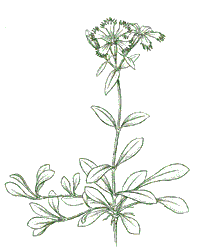
More famous wildflowers of the Southeast and Deep South: Asclepias syriaca (common milkweed), Callirhoe papaver (poppy mallow/wine cups), Coreopsis integrifolia (chipola trickseed), Gaillardia pulchella (blanket flower), Hepatica acutiloba (sharp-leaved hepatica), Hepatica americana, Mertensia virginica (Virginia bluebells), Phlox divaricata (woodland phlox), Senecio aureus (golden ragwort), Solidago species (goldenrods), Tradescantia hirsutifolius (spiderwort), Trillium underwoodii (Underwood's trillium), Trollius laxus (spreading globeflower), and Verbena canadensis (rose verain).
South Florida
Carphephorus corymbosus (Florida paintbrush)
"A showy fall bloomer that attracts butterflies and thrives in dry
soil."
—Sarah Kiefer, The Natives, Inc.
This perennial has downy, leafy stems 3 feet or taller. The flowerheads,
borne from July to December, are much like those of the better-known genus
Liatris, the blazing stars. The blooms are tubular and rose-colored.
Tolerates very dry sites. Full sun.
Zone 8.
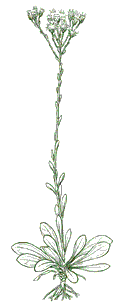
Helianthus debilis (Dune/Beach sunflower)
"Excellent perennial groundcover that attracts butterflies and is a great lawn alternative!"
—John Sibley, All Native Garden Center & Plant Nursery
A tall variety, 3 to 7 feet, with triangular, irregularly toothed, cucumber-like leaves. Year round, creamy yellow to pure white flowers with black centers bloom on its sturdy branches. A good cut flower. Grow in a moderately fertile, moist but well-drained neutral to alkaline soil. Full sun.
Zone 8-10.
Ruellia caroliniensis (Wild petunia)
"A good alternative to the aggressive, exotic species sold by many nurseries."
—Dan Walton, Florida Native Plants, Inc.
This long-blooming spreader re-seeds well. Its erect stems grow 10 to 15
inches tall, with 1-inch-wide, trumpet-shaped lilac to lavender-blue flowers.
In its native range, it is found in prairies, open woods, and rocky banks. Grow
in dry, acid soil. Full to partial sun. Does not tolerate salt.
Zone 5.
Florida has many other choice wildflowers as well: Dyschoriste oblongifolia (twin flower), Flaveria linearis (yellowtop), Gaillardia pulchella (blanket flower), Heliotropium angiospermum (scorpion's tail), Ipomoea pescaprae (railroad vine), Liatris spicata (gayfeather), Pityopsis graminifolia var. tracyi (silver leaf aster), Salvia coccinea (scarlet sage), Tradescantia ohioensis (spiderwort), and Verbena tampensis (Tampa verbena).
Prairies & Plains
Senna hebecarpa (Wild senna)
"Growing 4 to 8 feet tall, this plant can make a real statement! Its robust
form provides cover for wildlife, while the large seeds offer a nutritious
meal."
—Neil Diboll, Prairie Nursery
This sturdy, shrub-like plant is a long-lived, native legume. So while it is
bringing beauty to your garden, it's also adding nitrogen to the soil. Large,
feathery, compound leaves combine with clusters of creamy- to bright-yellow
flowers in July and August. Good for cut and dried flowers. Grow in moist,
well-drained, moderately fertile soil. Full sun or light shade.
Zone 3.
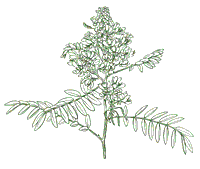
Silphium perfoliatum (Cup plant)
"A tall wildlife plant attracting songbirds, hummingbirds, and
butterflies."
—Patrick Stollfus, S & S Wildflowers
The flowerheads of this fascinating native have a thimble-like central "cone" and narrow, drooping, yellow rays in summer. Stems tower to 10 feet.
Immense, basal, bright-green leaves clasp the stem forming "cups" where water collects and is sipped by hummingbirds. Grows naturally in rich, moist soil and
full sun.
Zone 5-9.
Veronicastrum virginicum (Culver's root)
"A rare and spectacular tallgrass prairie beauty with candelabra spikes of
white and mauve flowers in July that attract numerous butterflies and
bees."
—John Morgan, Prairie Habitats Inc.
The inflorescence of this plant is given a fuzzy look by its projecting
stamens. In its native range, it can be found in moderately fertile,
humus-rich, moist soil in sun to partial shade.
Zone 3-8.
Old standbys of the prairies and plains include: Asarum canadense (wild ginger), Asclepias incarnata (swamp milkweed), Asclepias tuberosa (butterfly weed), Aster novae-angliae (New England aster), Aster oblongifolius (aromatic aster), Baptisia leucantha (wild false indigo), Clintonia borealis (blue-bead lily), Eupatorium purpureum (sweet Joe Pye weed), Geum triflorum (prairie smoke), Liatris ligulistylus (meadow blazing star), Lobelia cardinalis (cardinal flower), Petalostemun purpureum (purple prairie clover), Potentilla arguta (prairie cinquefoil), Solidago ohioensis (Ohio goldenrod), and Solidago riddellii (Riddell's goldenrod).
Rocky Mountains & Pacific Northwest
Erythronium grandiflorum (Trout lily)
"Erythronium species are some of the best wildflowers for
shade."
—Badassare Mineo, Siskiyou Rare Plant Nursery
The 2-inch, glowing, yellow blooms of this lily have distinctive, 3-lobed stigmas and white, yellow, or red-black anthers. Broad twin leaves emerge with
the flowers shortly after the snow melts, growing 5 to 13 inches high and 4 inches wide. Dormant from July to early March. Easy to grow in well-drained,
fertile soil.
Zone 3-8.
Lewisia rediviva (Bitterroot)
"A stunning ephemeral of the high plains, with enormous bright-pink flowers
that spring from the sand in some of the most barren-looking places."
— Rebecca Day-Skowron, Rocky Mountain Rare Plants
This 1 by 3-inch perennial is an excellent showy plant at higher elevations.
Narrow, small, and succulent quill-like, red-green leaves form in early spring.
Flowers bloom in June. Goes dormant in late summer, so be sure to mark its
location with a label. Easily grown from seed. Not tolerant of alkaline soil,
and needs good drainage.
Zone 4-7.
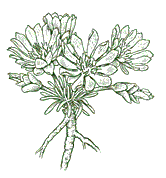
Geranium viscosissinum (Sticky geranium/Western cranesbill)
"Sticky geranium produces very bright pink flowers in midsummer. Its foliage has a nice orange-red fall color".
—Kathy Hutton, Plants of the Wild
The foliage of this easy-to-grow, bushy plant stretches 1 to 3 feet tall and is covered in sticky hairs. Bright pink to purple flowers bloom from July
through August, often with a second flush—and are edible. Water moderately in a rich, well-drained, slightly acidic soil. Partial shade to full sun. Drought tolerant.
Zone 4-10.
Other wonderful wildflowers for the Pacific Northwest/Rocky Mountain regions: Aquilegia formosa (western red columbine), Balsamorhiza sagittata (arrowleaf balsamroot), Calochortus nuttallii (fairy lantern), Iris douglasiana (iris pacific hybrid), Lomatium dissectum, and Penstemon whippleanus (Whipple's penstemon)
California
Eriogonum arborescens
(Santa Cruz Island buckwheat)
"A wonderful plant for attracting beneficial insects to the garden and for accenting the rear of any dry perennial border."
—Erin O'Doherty, Native Revival Nursery
This neat-looking shrub grows to 3 feet in coastal areas, but will be smaller inland. It has gray foliage with pink flowers, which bloom early summer
to autumn and are great in dried-flower arrangements. It is very drought tolerant. When established, water just once a month. Snow has a tendency to
break its branches. Full sun.
Zone 8.
Fragaria platypetala (Western alpine strawberry)
"Most strawberries have green foliage. This one has gray. It's a great plant to plug up the hole in the flagstone."
—Celeste Wilson, Las Pilitas
A deciduous, flat perennial strawberry with gray leaves. Its 5-petaled flowers are white and borne in clusters. The tasty red fruits are hidden among
the leaves. Treat as a regular strawberry plant and use for ground cover. Grows naturally in fertile, moist but well-drained, neutral to alkaline soils in full
sun or shade.
Zone 4-10.
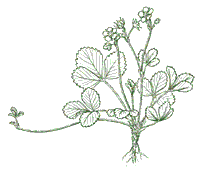
Camissonia cheiranthifolia (Beach evening primrose)
"One of the most conspicuous of plants from the unique dune community. Flowers can be found almost all year."
—Mike Evans, Tree of Life Nursery
This primrose has creeping, grayish, downy stems, 4 to 24 inches long, with small gray-green leaves. During its principal blooming season (spring through
summer), it is adorned with numerous bright yellow flowers. Tolerant of just about any kind of soil, though it will perform best in sandy loam. Full sun.
Zone 8.
Other handsome California natives include: Armeria maritima (sea thrift), Asclepias speciosa (showy milkweed), Calochortus albus (mariposa lily), Erigeron glaucus (seaside daisy); Eschscholzia californica var. maritima (California poppy), Gilia tricolor (bird's eye gilia), Linanthus grandiflorus (grand linanthus), Lupinus nanus (sky lupine), Mentzelia lindleyi (blazing star), Nemophila menziesii (baby blue-eyes), Salvia columbariae, and Sisyrinchium bellum (blue-eyed grass).
The Southwest
Berlandiera lyrata (Chocolate flower)
"An extremely drought tolerant perennial with a fragrance of chocolate that fills the morning air. A must for chocolate lovers!"—Mark Myers, Plants
of the Southwest
The chocolate flower grows 1-1/2 feet tall with silvery foliage. Its pale yellow and maroon daisy flowers bloom in summer, opening in the morning and
nodding in the heat of the afternoon. The blooms are used in dried arrangements and as a seasoning. Grow in well-drained, moderately fertile soil and full sun.
Zone 7-9.
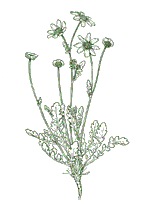
Dyschoriste lineris (Snake herb)
"Resembling a small rosemary, this heat- and drought-tolerant ground-hugging plant looks great between agaves, yuccas, dasylirions, and nolinas."
—Carl M. Schoenfeld, Yucca Do Nursery
This plant's delicate, light green foliage forms a low mound, usually about 10 inches by 3 feet across, which becomes dotted with small blue-purple
bell-like flowers from early spring to late fall. It loves a hot and dry
location and will thrive in almost any soil. This Texas native is excellent on
a slope, preventing soil erosion from wind or rain.
Zone 7-9.
Penstemon strictus (Rocky Mountain penstemon
"Another great wildflower that doesn't get too 'wild' looking. Easy to care
for and maintain."
—Kerry Krumrine, GO Native! nursery
This showy native penstemon has large, deep-green leaves and brilliant
blue-purple blooms in spring. The stamens of these flowers have dense hairs
that make them look like they're covered in white wool. The plant is a good
ground cover for a dry, gravelly slope. One foot tall by 1 foot wide. Needs
little water and good drainage. Full sun.
Zone 4-9.
And don't forget the following wildflowers native to the Southwest: Agastache cana (wild hyssop), Aquilegia chrysantha (golden spur columbine), Centaurea rothrockii (basket flower), Echinacea purpurea (purple coneflower), Helianthus mollis (downy sunflower), Hymenoxys acaulis (angelita daisy), Penstemon parryi (Parry's penstemon), Penstemon pinifolius (pineleaf penstemon), Verbena goodingii (native verbena), and Zinnia grandiflora (prairie zinnia).
The Nurseries
Native plants are threatened by collectors who dig them up from the wild. Make sure to purchase your wildflowers from nurseries (like the following) that propagate what they sell!
Northeast & Mid-Atlantic
Amanda's Garden8410 Harper's Ferry Road
Springwater, NY 14560
phone: (585)- 669-2275
website: www.amandagarden.com Munchkin Nursery & Gardens
323 Woodside Drive NW
Depauw, IN 47115-9039
phone: (812) 633-4858
website: www.munchkinnursery.com The Primrose Path
921 Scottdale-Dawson Road
Scottdale, PA 15683
phone: (724) 887-6756
website: www.theprimrosepath.com Toadshade Wildflower Farm
53 Everittstown Road
Frenchtown, NJ 08825
phone: (908) 996-7500
website: www.toadshade.com WE-DU Nurseries
Route 5, Box 724
Marion, NC 28752
phone: (828) 738-8300
Wild Earth Native Plant Nursery
P.O. Box 7258
Freehold, NJ 07728
phone: (732) 308-9777
Southeast & Deep South
Appalachian Wildflower Nursery723 Honey Creek Road
Reedsville, PA 17084
phone: (717) 667-6998 Eco-Gardens
P.O. Box 1227
Decatur, GA 30031
phone: (404) 294-6468 Environmental Equities, Inc.
P.O. Box 7180
Hudson, FL 34674-7180
phone: (941) 355-1267 Mail-Order Natives
P.O. Box 9366
Lee, FL 32059
phone: (850) 971-5416
website: www.wegrowit.com Native Nurseries
1661 Centerville Road
Tallahasse, FL 32308
phone: (850) 386-8882
website: www.nativenurseries.com Niche Gardens
1111 Dawson Road
Chapel Hill, NC 27516
phone: (919) 967-0078
website: www.nichegardens.com Southern Horticulture Nursery
1690 A1A South
St. Augustine, FL 32084
phone: (904) 471-0440
South Florida
All Native Garden Center & Plant Nursery108 2nd Street
Fort Myers, FL 33907-2409
phone: (941) 936-6975 Florida Native Plants, Inc.
730 Myakka Road
Sarasota, FL 34240
phone: (941) 322-1915 Runway Growers Inc.
2891 SW 36 Street
Fort Lauderdale, FL 35312
phone: (954) 584-0269 The Natives, Inc.
P.O. Box 946
Davenport, FL 33836
phone: (863) 422-6664
Prairies & Plains
Landscape Alternatives, Inc.1705 St. Albans Street North
Roseville, MN 55113-6554
phone: (651) 488-3142 Prairie Habitats Inc.
P.O. Box 1
Argyle, Manitoba,
Canada R0C 0B0
phone: (204) 467-9371
website: www.prairiehabitats.com Prairie Moon Nursery
Rt. 3, Box 163
Winona, MN 55987
phone: (507) 452-1362
Prairie Nursery
P.O. Box 306
Westfield, WI 53964
phone: (800) 476-9453
website: www.prairienursery.com Prairie Restorations, Inc.
P.O. Box 327
Princeton, MN 55371
phone: (612) 389-4342
website: www.prairieresto.com Prairie Ridge Nursery
9738 Overland Road
Mt. Horeb, WI 53572-2832
phone: (608) 437-5245 S & S Wildflowers
W4401 Highway 33
Pardeeville, WI 53954
phone: (608) 429-3188
Pacific Northwest & Rocky Mountains
AlplainsP.O. Box 489
Kiowa, CO 80117-0489
phone: (303) 621-2590 Nichols Garden Nursery
1190 Salem Road
Albany, OR 97321-4580
phone: (541) 928-9280
website: www.nicholsgardennursery.com Northplan/Mountain Seed
P.O. Box 9107
Moscow, ID 83843-1607
phone: (208) 882-8040 Plants of the Wild
P.O. Box 866
Tekoa, WA 99033
phone: (509) 284-2848
website: www.plantsofthewild.com Rocky Mountain Rare Plants
1706 Deerpath Road
Franktown, CO 80116-9462
phone: (303) 660-6498
Siskiyou Rare Plant Nursery
2115 Talent Avenue
Talent, OR 97540
phone: (541) 535-7103
website: www.siskiyourareplantnursery.com Southwestern Native Seeds
P.O. Box 50503
Tucson, AZ 85703
California
Elkhorn Native Plant NurseryP.O. Box 270
Moss Landing, CA 95039
phone: (831) 763-1207
website: www.elkhornnursery.com Larner Seeds
P.O. Box 407
Bolinas, CA 94924
phone: (415) 868-9407 Las Pilitas
3232 Las Pilitas Road
Santa Margarita, CA 93453
phone: (805) 438-5992
website: www.laspilitas.com Moon Mountain Wildflowers
P.O. Box 725
Carpinteria, CA 93014-0725
phone: (805) 684-2565 Native Revival Nursery
8022 Soquel Drive
Aptos, CA 95003
phone: (831) 684-1811 S & S Seeds
P.O. Box 947
Albany, OR 97321
Phone: (541) 928-5868
website: ssseeds.com Tree of Life Nursery
P.O. Box 635
San Juan Capistrano, CA 92693
phone: (949) 728-0685
website: www.treeoflifenursery.com Yerba Buena Nursery
19500 Skyline Blvd.
Woodside, CA 94062
phone: (650) 851-1668
website: www.yerbabuenanursery.com
The Southwest
GO Native!P.O. Box 3631
Las Cruces, NM 88003
phone: (800) 880-4698
website: www.gonative.com Mountain States Wholesale Nursery
P.O. Box 2500
Litchfield Park, AZ 84340-2500
phone: (623) 247-8509 Plants of the Southwest
Agua Fria
Route 6, Box 11A
Sante Fe, NM 87501
phone: (800) 788-SEED
website: www.plantsofthesouthwest.com Yucca Do Nursery, Inc.
Route 3, Box 104
Hempstead, TX 77445
phone: (409) 826-4580


